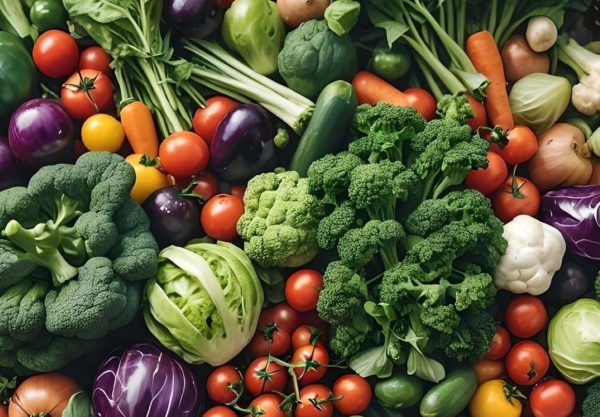When I was a kid, I wasn’t allowed to leave the table until I ate all of my vegetables. “They’re good for you!” my Mom would exclaim.
The problem was, she didn’t know how to cook them.
Broccoli and cauliflower were soggy masses of florets that had been boiled to death. Asparagus turned into a slimy mess. Carrots lost every bit of their crunch…and green beans from a can were always dreaded.
There wasn’t an ounce of flavor in any of them. (Needless to say, I wasn’t a vegetable-loving kid.)
Eventually I discovered the exquisite joy of eating fresh, flavorful, vegetables that had been cooked properly. And I’ve been eating them ever since!
But I often wonder what would have happened if I had never discovered that vegetables can taste good when they’ve been cooked to perfection.
Would I be one of those patients I often run into who tells me they don’t like vegetables? Would I be missing out on all of the remarkable health benefits that come with them… feeling older than my years… sickly… or worse?
Here’s the deal…
People Aren’t Eating Their Veggies!
Nine out of every 10 American adults don’t eat the recommended two to three cups of vegetables each day.
This means that only one out of every 10 people actually eat more than two cups of vegetables a day! (Are you “the one?”)
This is an absolutely horrible statistic. And it’s one we should all be ashamed of, because vegetables are absolutely crucial to living a long, healthy and vital life that’s not plagued with disease.
- Veggies protect against high blood pressure, heart disease and stroke.
- They boost your immune system, enhance your bone health, slow down mental decline and protect against all types of cancer.
- Vegetables preserve your vision, prevent diabetes, keep you thin and support a healthy gut microbiota (which alone keeps you healthy on so many different levels).
- Some of them can even turn off the expression of bad genes, and turn good ones on.
- It’s estimated that about a third of early deaths could be prevented… just by eating a diet high in fruits and vegetables.
If you don’t eat your vegetables, you won’t get any of these amazing health benefits.
If you boil them to death, you won’t get any of these phenomenal health advantages either. That’s because boiling destroys all of the life-extending nutrients in them. (It also makes them taste like crap. So there really is no point in eating mushy, flavorless vegetables.)
3 Easy Ways to Start Loving Your Veggies
I’m no gourmet chef, but I do know of a lot great ways to make delicious vegetables that retain all of their nutrient power. And when I introduce these methods to vegetable nay-saying patients, I find that they suddenly discover – much to their surprise – that they DO like vegetables after all.
Roasted and grilled vegetables are probably my favorite. They’re bursting with flavor and so easy to make that it doesn’t really even require cooking skills. And you can roast/grill almost any vegetable you find.
I personally enjoy broiled Portobello mushroom cap. You can top it with anything you want. I like mine with tomatoes, onions, olive oil, spinach and garlic. Broil 3-4 minutes or until tender…or stuff it with whatever you like and bake it.
Roasted cauliflower is another favorite of mine. Just slice a head of cauliflower from top to bottom in two inch “steaks.” Lay the pieces flat in a baking pan and drizzle a little extra virgin olive oil over them. Toss in some pine nuts – and whatever else sounds good – and roast them in the oven until they’re slightly tender.
You can also try roasted/grilled zucchini, Brussels sprouts, squash, broccoli, asparagus, eggplant and a slew of other vegetables.
Stir fry and sauté are also great ways to cook your veggies. When your pan is hot add a small amount of high smoke point cooking oil like sesame or avocado. Then just toss in whatever veggies, spices and herbs you like. Sauté for 5-8 minutes, toss frequently. (Always add garlic in the last minute to avoid burning it).
Steaming is another easy way to make crunchy, flavorful vegetables while preserving their health benefits. All you need is a steamer basket or stainless-steel colander and a pot that it will fit in.
Load the basket/colander up with your veggies while you wait for your water to boil (water should be just filled to just below the bottom of the basket.) Set the basket in the boiling water and place a loose-fitting lid on top. Most veggies are done within 3-6 minutes; so quick and easy.
I like to toss steamed vegetables in seasoned extra virgin olive oil after they’re cooked. You can also check online for other seasoning ideas like hot chili, balsamic, ginger, lemon herb and other flavors and sauces. The same veggies with a different sauce or seasoning becomes an entirely different meal.
I also recommend adding more vegetables even when they aren’t the star of the meal. For example, you can put them in your omelets, salads, smoothies, soups, wraps and wherever else you can think of.
And don’t forget… buy organic whenever possible.
Sources:
Pollock RL. The effect of green leafy and cruciferous vegetable intake on the incidence of cardiovascular disease: A meta-analysis. JRSM Cardiovasc Dis. 2016 Jan-Dec; 5: 2048004016661435.
Fujii H, et al. Daily intake of green and yellow vegetables is effective for maintaining bone mass in young women. Tohoku Journal of Experimental Medicine. 2009;218:149-154.
Morris MC, et al. Nutrients and bioactives in green leafy vegetables and cognitive decline: Prospective study. Neurology. 2018 Jan 16;90(3):e214-e222.
Khan MA, et al. Sulforaphane Reverses the Expression of Various Tumor Suppressor Genes by Targeting DNMT3B and HDAC1 in Human Cervical Cancer Cells. Evid Based Complement Alternat Med. 2015; 2015: 412149.






